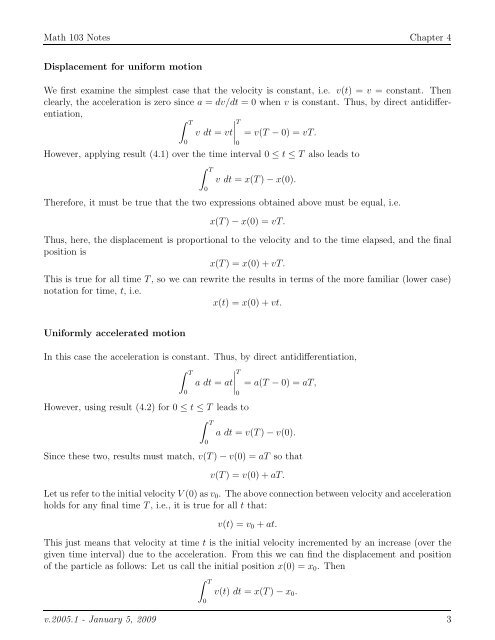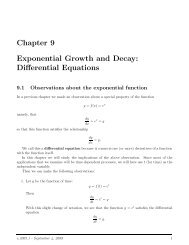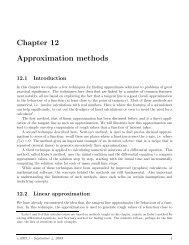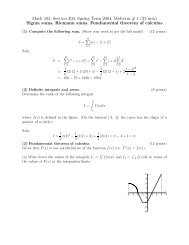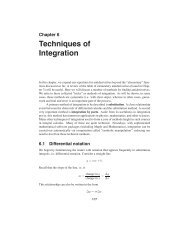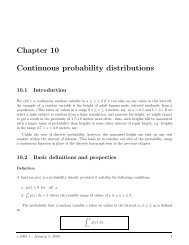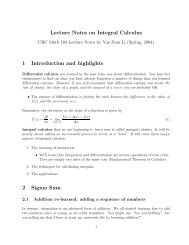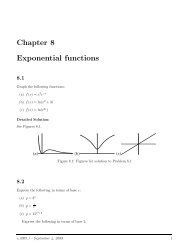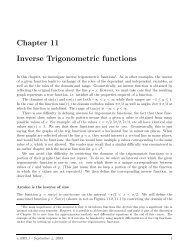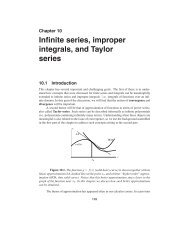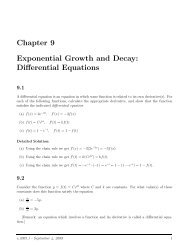Chapter 4 Applications of the definite integral to rates, velocities and ...
Chapter 4 Applications of the definite integral to rates, velocities and ...
Chapter 4 Applications of the definite integral to rates, velocities and ...
Create successful ePaper yourself
Turn your PDF publications into a flip-book with our unique Google optimized e-Paper software.
Math 103 Notes <strong>Chapter</strong> 4Displacement for uniform motionWe first examine <strong>the</strong> simplest case that <strong>the</strong> velocity is constant, i.e. v(t) = v = constant. Thenclearly, <strong>the</strong> acceleration is zero since a = dv/dt = 0 when v is constant. Thus, by direct antidifferentiation,∫ TTv dt = vt∣ = v(T − 0) = vT.0However, applying result (4.1) over <strong>the</strong> time interval 0 ≤ t ≤ T also leads <strong>to</strong>∫ T00v dt = x(T) − x(0).Therefore, it must be true that <strong>the</strong> two expressions obtained above must be equal, i.e.x(T) − x(0) = vT.Thus, here, <strong>the</strong> displacement is proportional <strong>to</strong> <strong>the</strong> velocity <strong>and</strong> <strong>to</strong> <strong>the</strong> time elapsed, <strong>and</strong> <strong>the</strong> finalposition isx(T) = x(0) + vT.This is true for all time T, so we can rewrite <strong>the</strong> results in terms <strong>of</strong> <strong>the</strong> more familiar (lower case)notation for time, t, i.e.x(t) = x(0) + vt.Uniformly accelerated motionIn this case <strong>the</strong> acceleration is constant. Thus, by direct antidifferentiation,∫ TTa dt = at∣ = a(T − 0) = aT,However, using result (4.2) for 0 ≤ t ≤ T leads <strong>to</strong>0∫ T00a dt = v(T) − v(0).Since <strong>the</strong>se two, results must match, v(T) − v(0) = aT so thatv(T) = v(0) + aT.Let us refer <strong>to</strong> <strong>the</strong> initial velocity V (0) as v 0 . The above connection between velocity <strong>and</strong> accelerationholds for any final time T, i.e., it is true for all t that:v(t) = v 0 + at.This just means that velocity at time t is <strong>the</strong> initial velocity incremented by an increase (over <strong>the</strong>given time interval) due <strong>to</strong> <strong>the</strong> acceleration. From this we can find <strong>the</strong> displacement <strong>and</strong> position<strong>of</strong> <strong>the</strong> particle as follows: Let us call <strong>the</strong> initial position x(0) = x 0 . Then∫ T0v(t) dt = x(T) − x 0 .v.2005.1 - January 5, 2009 3


